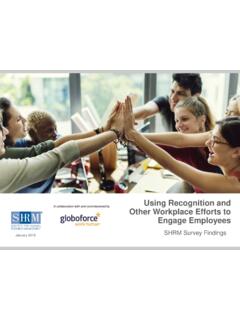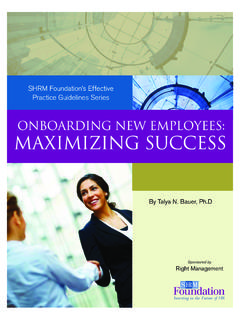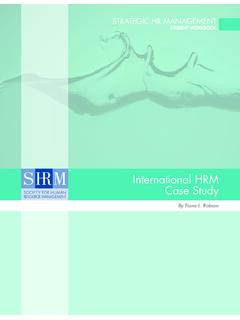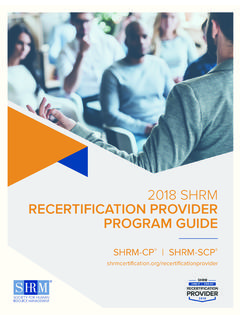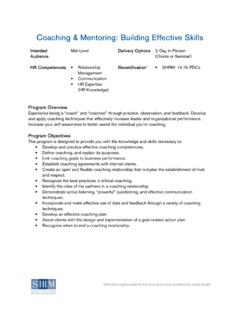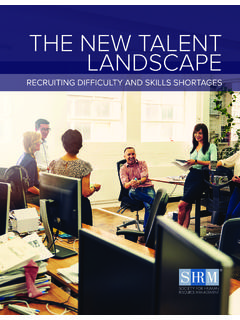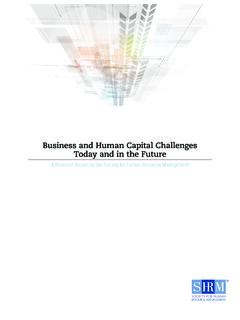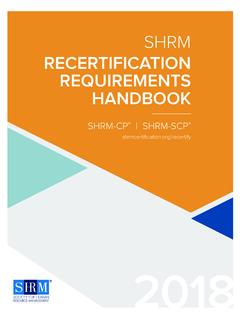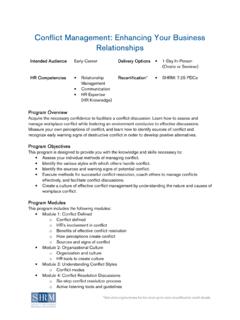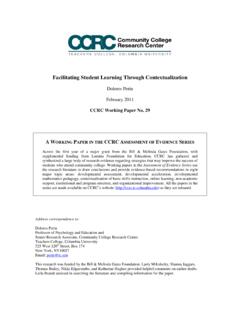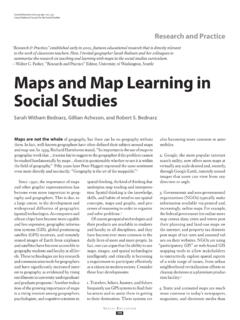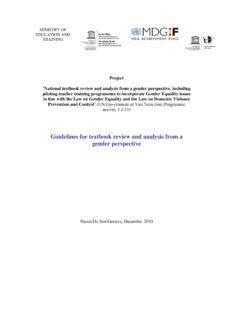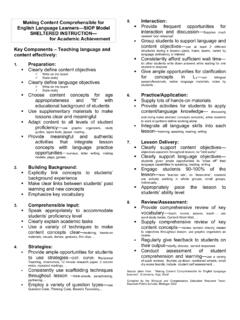Transcription of SHRM Foundation’s Effective Practice Guidelines Series
1 SHRM Foundation s Effective Practice Guidelines SeriesBy Talya N. Bauer, byRight Management Onboarding New Employees: Maximizing SuccessTalya N. Bauer, New Employees:Maximizing Success SHRM FOuNdatiON S EFFE ctivE Practice Guidelines SERiESSponsored by Right ManagementThis publication is designed to provide accurate and authoritative information regarding the subject matter covered. Neither the publisher nor the author is engaged in rendering legal or other professional service. If legal advice or other expert assistance is required, the services of a competent, licensed professional should be sought. Any federal and state laws discussed in this book are subject to frequent revision and inter-pretation by amendments or judicial revisions that may significantly affect employer or employee rights and obligations. Readers are encour-aged to seek legal counsel regarding specific policies and practices in their book is published by the SHRM Foundation, an affiliate of the Society for Human Resource Management (SHRM ).
2 The interpretations, conclusions and recommendations in this book are those of the author and do not necessarily represent those of the SHRM Foundation. 2010 SHRM Foundation. All rights reserved. Printed in the United States of publication may not be reproduced, stored in a retrieval system or transmitted in whole or in part, in any form or by any means, electronic, mechanical, photocopying, recording or otherwise, without the prior written permission of the SHRM Foundation, 1800 Duke Street, Alexandria, VA SHRM Foundation is the 501(c)3 nonprofit affiliate of the Society for Human Resource Management (SHRM). The SHRM Foundation maximizes the impact of the HR profession on organizational decision-making and performance by promoting innovation, education, research and the use of research-based knowledge. The Foundation is governed by a volunteer board of directors, comprising distinguished HR academic and Practice leaders.
3 Contributions to the SHRM Foundation are tax deductible. For more information, contact the SHRM Foundation at (703) 535-6020. Online at New Employees:Maximizing SuccesS10-0645 contentstable of Maximizing SuccesSv Forewordvii Acknowledgmentsix About the Author1 Onboarding New Employees: Maximizing Success 1 A Range of Approaches 2 The Four C s 4 Using New Tools to Keep Onboarding on Track 4 Short-Term Outcomes of Onboarding: New Employee Adjustment 6 Long-Term Outcomes of Onboarding: Attitudes and Behaviors 8 Onboarding and HRM 13 Feedback Tools 13 Onboarded Employees: Executives vs. Hourly Workers 15 Implications for Small to Medium Organizations 16 Onboarding Best Practices 17 Conclusion19 References25 Sources and Suggested ReadingsvAccording to recent data, more than 25 percent of the population experiences some type of career transition each year.
4 Unfortunately, many transitions are not successful. Half of all hourly workers leave new jobs in the first four months, and half of senior outside hires fail within 18 months. Clearly, there is room for improvement. An important way leaders can combat these challenges is to implement a robust employee onboarding program. Onboarding helps new hires adjust to the social and performance aspects of their jobs so they can quickly become productive, contributing members of the organization. This report, Onboarding New Employees: Maximizing Success, will provide the tools you need to create an Effective onboarding process in your company. In 2004, the SHRM Foundation created this Effective Practice Guidelines Series for busy HR professionals like you. It s a challenge for practitioners with limited time to keep up with the latest research results. By integrating research findings on what works and expert opinion on how to conduct Effective HR Practice into a single publication, we make theory and Practice accessible to reports in this Series include The Search for Executive Talent, Employment Downsizing and Its Alternatives, Recruiting and Attracting Talent, and Human Resource Strategy.
5 This report is the 12th in the Series . Subject matter experts write the reports, and the drafts are then reviewed by both academics and practitioners to ensure that the material is research-based, comprehensive and presented in an easy-to-use format. We also include a Suggested Readings section as a convenient reference tool. All reports are available online for free download at Series supports our vision for the SHRM Foundation to maximize the impact of the HR profession on organizational decision-making and performance by promoting innovation, education, research and the use of research-based knowledge. Overall, the Foundation has a strategic focus on initiatives designed to help organizations maximize leadership talent. We are confident that the Effective Practice Guidelines Series takes us one step closer to making our vision a reality.
6 Please let us know how we are doing!Mary A. Gowan, Chair, SHRM Foundation Research Evidence Committee Dean and Professor of Management Martha and Spencer Love School of Business Elon UniversityForewordviiAcknowledgmentsThe SHRM Foundation is grateful for the assistance of the following individuals in producing this report: content editorM. Susan Taylor, Dean s Professor of Human Resources Co-Director, Center for Human Capital, Innovation and Technology Robert H. Smith School of Business University of MarylandreviewersLaTonia Dean-Brown Associate Director, Human Resources Big Brothers Big Sisters of AmericaGregory Karanastasis, PHR Director, Talent Acquisition The McGraw-Hill CompaniesMartina S. McAndrew, SPHR Director, Strategic Recruitment Baker Tilly Virchow Krause, LLPS uzanne Ritchie Onboarding & Early Engagement Consultant TD Ameritrade Corporate Learning & DevelopmentProject ManagerBeth M.
7 McFarland, CAE Manager, Special Projects SHRM FoundationMajor funding for the Effective Practice Guidelines Series is provided by the HR Certification Institute and the Society for Human Resource Management. ixAbout the Author: Talya N. Bauer Talya N. Bauer is the Cameron Professor of Management at Portland State University in Oregon. Dr. Bauer is an award-winning teacher and researcher. She conducts research about relationships at work. More specifically, she studies the areas of new-hire onboarding, recruitment, selection, overqualification, mentoring and leadership, and has written numerous journal articles. Her scholarship has appeared in the Academy of Management Journal, Academy of Learning and Education Journal, Journal of Applied Psychology, Journal of Management and Personnel Psychology. Dr. Bauer has been a guest speaker at the SHRM annual conference and has acted as a consultant for dozens of government, Fortune 1000 and start-up organizations.
8 She is involved in professional organizations and conferences, serving in elected positions, including as a member of the Human Resource Management Executive Committee of the Academy of Management and Member at Large for the Society for Industrial and Organizational Psychology. Dr. Bauer is currently the editor of the Journal of Management and has served on the editorial boards of the Journal of Applied Psychology, Personnel Psychology and the Journal of Management. She has co-authored two textbooks Organizational Behavior and Principles of Management and two management graphic novels with Jeremy Short, Dave Ketchen and illustrator Len Simon Atlas Black: Managing to Succeed and Atlas Black: Management Guru. Her work has been discussed in media outlets, including the New York Times, BusinessWeek, Wall Street Journal, Oregonian, Portland Business Journal, NPR s All Things Considered and KGW and conventional wisdom both suggest that employees get about 90 days to prove themselves in a new job.
9 The faster new hires feel welcome and prepared for their jobs, the faster they will be able to successfully contribute to the firm s Onboarding New Employees: Maximizing SuccessOnboarding New Employees: Maximizing SuccessAfter Effective recruitment and selection, one of the most important ways that organizations can improve the effectiveness of their talent management systems is through the strategic use of onboarding. Onboarding is the process of helping new hires adjust to social and performance aspects of their new jobs quickly and smoothly. This should always be a priority for HR departments, because in the United States, every year more than 25 percent of the working population experiences career In Fortune 500 companies alone, about 500,000 managers take on new roles each year, and overall, managers begin new jobs every two to four years.
10 Unfortunately, in the midst of all these transitions: Half of all senior outside hires fail within 18 months in a new Half of all hourly workers leave new jobs within the first 120 This report will explain why onboarding is so important, where it fits into the larger HR context, how HR managers can proactively manage onboarding and, finally, how new employees can help facilitate their own onboarding process. A Range of ApproachesResearch and conventional wisdom both suggest that employees get about 90 days to prove themselves in a new job. Every organization has its own version of the complex process through which new hires learn attitudes, knowledge, skills and behaviors required to function effectively. Academic researchers who study onboarding also use the term organizational No matter what the terminology, the bottom line is that the faster new hires feel welcome and prepared for their jobs, the faster they will be able to successfully contribute to the firm s mission.
